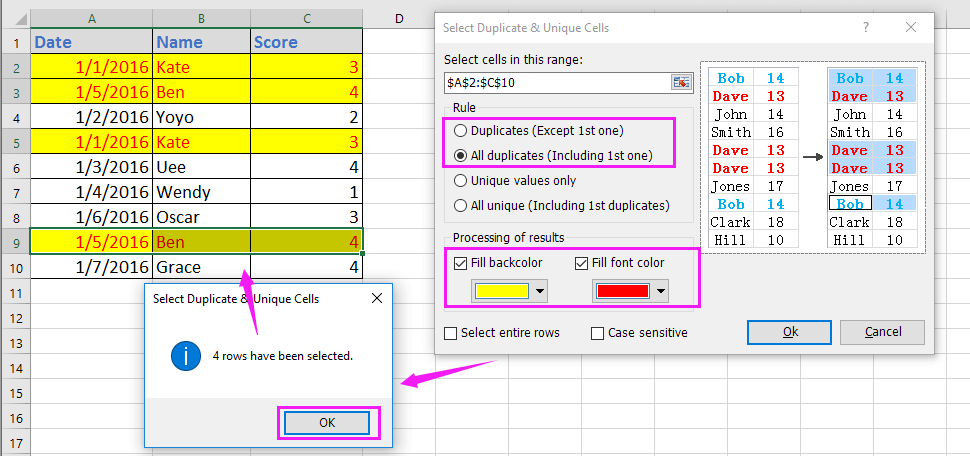Effortlessly Spot Duplicates Across Two Excel Sheets

If you've ever had to compare data across two different Excel sheets to find duplicate values or entries, you know how painstakingly time-consuming and error-prone it can be. Fortunately, Excel offers several tools and functions that can make this task much simpler and more efficient. In this comprehensive guide, we'll explore different methods to effortlessly spot duplicates across two Excel sheets.
Understanding Duplicate Values

Duplicates in Excel are entries or records that appear more than once within a dataset. Identifying these duplicates can be essential for tasks such as data cleaning, data analysis, or even to ensure data integrity in large datasets. Here’s why you might need to compare two sheets:
- To eliminate redundant entries
- To merge or synchronize data
- To track changes or updates
- To verify data consistency across reports or records
Method 1: Using Conditional Formatting

Conditional Formatting is a feature in Excel that allows you to change the appearance of cells based on certain conditions. Here’s how you can use it to spot duplicates:
- Open both sheets in one Excel file or have two files open side by side.
- In the first sheet, go to the column you want to check for duplicates, then:
- Select the cells in that column.
- Navigate to ‘Home’ > ‘Styles’ > ‘Conditional Formatting’ > ‘New Rule’.
- Choose ‘Use a formula to determine which cells to format’.
- Enter this formula:
=COUNTIF(Sheet2!A:A, A1) > 0(assuming Sheet2 is your second sheet and A:A is the column to compare). Adjust the formula according to your needs. - Click on ‘Format’, choose a format (like red fill), then click ‘OK’ and apply.
Method 2: VLOOKUP Function

VLOOKUP can help you find duplicates by searching for a value in the second sheet based on the entries in the first sheet:
- In your first sheet, add a new column (let’s call it ‘Duplicate Check’).
- Enter this formula in the first cell of this column:
=IF(ISERROR(VLOOKUP(A2,Sheet2!A:A,1,FALSE)),“”, “Duplicate”) - Drag the formula down to fill the rest of the cells in the column. Any cell displaying “Duplicate” indicates that the corresponding entry in column A exists in Sheet2.
Method 3: Using Power Query

Power Query, available in Excel 2010 and later versions, provides an advanced way to merge and compare datasets:
- Load both sheets into Power Query:
- Go to the ‘Data’ tab, click ‘Get Data’ or ‘From Table/Range’.
- Load the data from both sheets into Power Query.
- Merge the Queries:
- Go to ‘Home’ > ‘Merge Queries’ > ‘Merge’.
- Select a common column for joining (e.g., ID or Name).
- Choose how you want to join (Left Outer might be best for duplicates).
- Click ‘OK’ and finish merging.
- After merging, you can filter for duplicate values in the query editor.
- Load the result back into Excel.
💡 Note: Ensure that the columns you are comparing have the same data type and format for accurate results.
Method 4: Advanced Filter

Excel’s Advanced Filter can also be used for spotting duplicates:
- Select the range in your first sheet where you want to check for duplicates.
- Go to ‘Data’ > ‘Sort & Filter’ > ‘Advanced’.
- In the Advanced Filter dialog, choose:
- ‘Copy to another location’
- Specify the List range and criteria range (which can be the same as the list range if you want all unique values from there).
- Uncheck ‘Unique records only’ to include duplicates.
- Click ‘OK’ to filter duplicates into the specified area.
Comparing Sheets with Different Structures

When your sheets have different structures but share common data fields:
- Map the columns: Identify and map the common columns from both sheets that will be used for comparison.
- Data normalization: Ensure data types match across the sheets to avoid false negatives in your duplicate search.
- Utilize Named Ranges: Using named ranges can make your formulas more readable and less prone to errors when referencing cells from different sheets.
💡 Note: Make sure to keep your data clean before comparing. Remove any unwanted spaces, check for case sensitivity, and ensure consistency in data formatting.
In today’s data-driven world, the ability to efficiently spot duplicates across two Excel sheets is invaluable. Whether you're a data analyst or just someone who manages large datasets occasionally, mastering these methods will save you time and enhance your workflow. Remember, while these techniques are designed for Excel, similar principles can be applied in other spreadsheet software like Google Sheets or LibreOffice Calc. Each method has its advantages, from the visual cues provided by Conditional Formatting to the detailed merging capabilities of Power Query. Choose the one that best fits your project's needs and start comparing sheets with confidence and precision.
What should I do if my sheets have different column names?

+
When column names differ between sheets, map them to common or temporary headers for comparison. Use named ranges or formula adjustments to make this process smoother.
Can I automate the process of finding duplicates?

+
Yes, you can automate the process using VBA scripts or by setting up Power Query to refresh automatically. However, for occasional use, manual or semi-automated methods might be sufficient.
How do I handle large datasets?

+
For large datasets, using Power Query or advanced Excel functions like VLOOKUP or Index-Match might be more efficient. These tools can handle larger volumes of data with less performance impact.
Is there a way to compare sheets across different Excel files?

+
Yes, by opening both files simultaneously or using Power Query to connect to external files, you can perform comparisons across separate Excel workbooks.
How can I ensure data consistency when comparing for duplicates?

+
Ensure data formatting and type consistency, remove or standardize extra spaces, and check for case sensitivity to reduce false positives during your duplicate checks.



